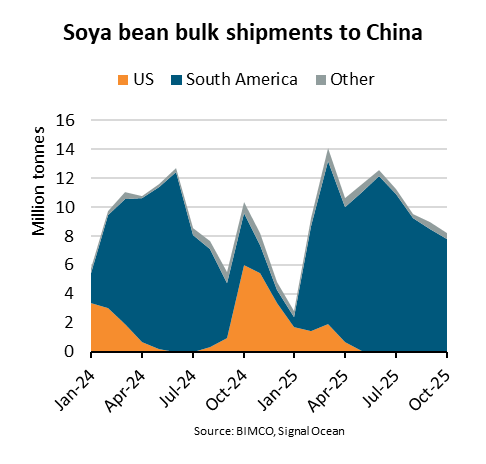The agreement is expected to be positive for the dry bulk market and the US and Chinese economies. Besides the import targets for soya beans, China agreed to lower tariffs for US grains and meat and to resume US sorghum imports. On the other hand, the US agreed to lower tariffs on Chinese goods by 10 percentage points. Both countries also agreed to suspend port fees on each other’s ships for one year.

The trade agreement provides relief for US soya bean shipments which have fallen 27% y/y so far this year. Although the US managed to boost shipments to destinations other than China, it has not been enough to mitigate a 65% y/y drop in shipments to China. Chinese imports, however, have still increased 5% y/y during the period, supported by a 21% y/y increase in shipments from South America.
“Over the coming months, we expect to see inventory building in China, as purchasing of US cargoes increases. Meanwhile, South America’s upcoming harvest is expected to drive down prices, further encouraging purchasing. The panamax segment is expected to be the main beneficiary of this increase as it transports 93% of soya bean cargoes to China,” says Gouveia.
Soya bean prices have already shifted, impacted by the outcome of the trade negotiations. US prices hit a 15-month high while Brazilian prices dropped, prompting China to increase purchasing.
Overall, the return of US soya bean shipments to China could lead to lower volumes from South America compared to 2025.
Traditionally, this shift would have reduced tonne-mile demand due to shorter sailing distances. However, since 2022, US shipments have increasingly bypassed the Panama Canal, opting instead for the longer route via the Cape of Good Hope, making their distances comparable to those from South America.
“In the medium term, China’s soya bean demand is expected to continue growing, supported by rising meat production, especially poultry. However, shipments of US soya beans might not rise beyond agreed volumes, as Chinese buyers often favour South American cargoes due to lower prices. Risks to the demand outlook include Chinese government efforts to reduce soya bean imports and to cut overcapacity in pork production,” says Gouveia.
Source: BIMCO




